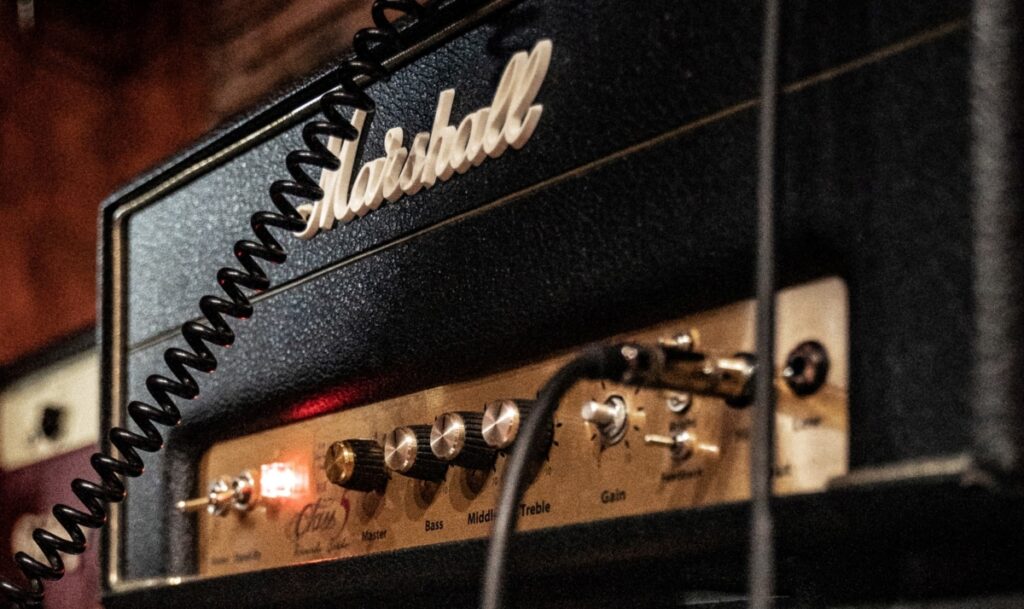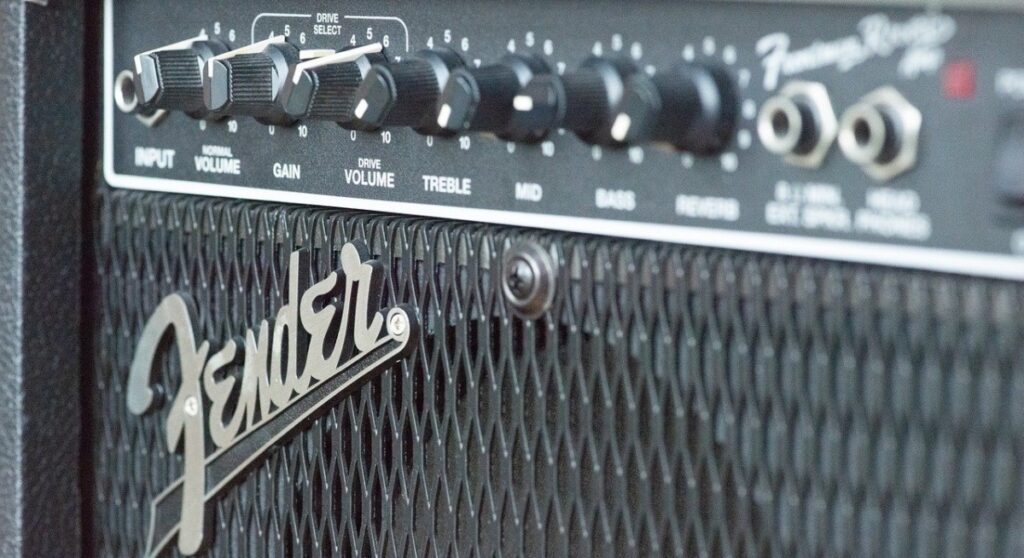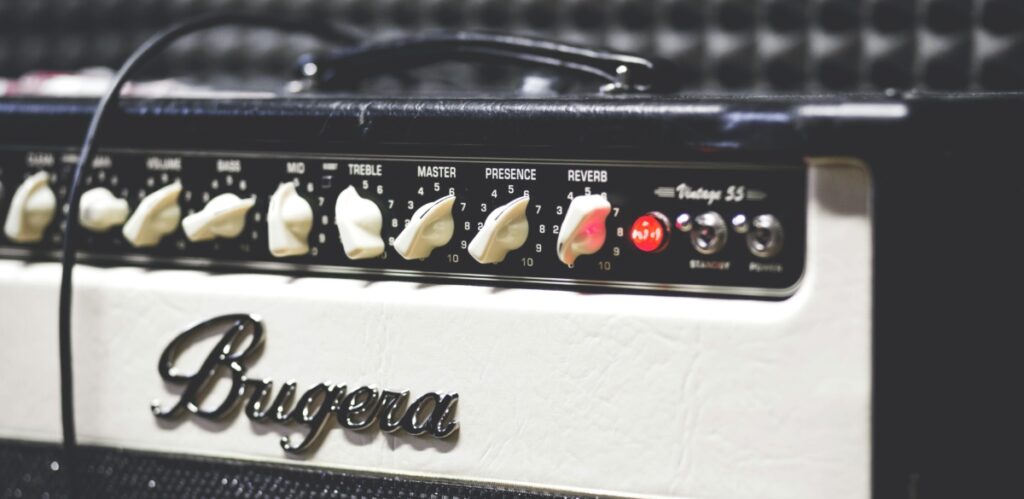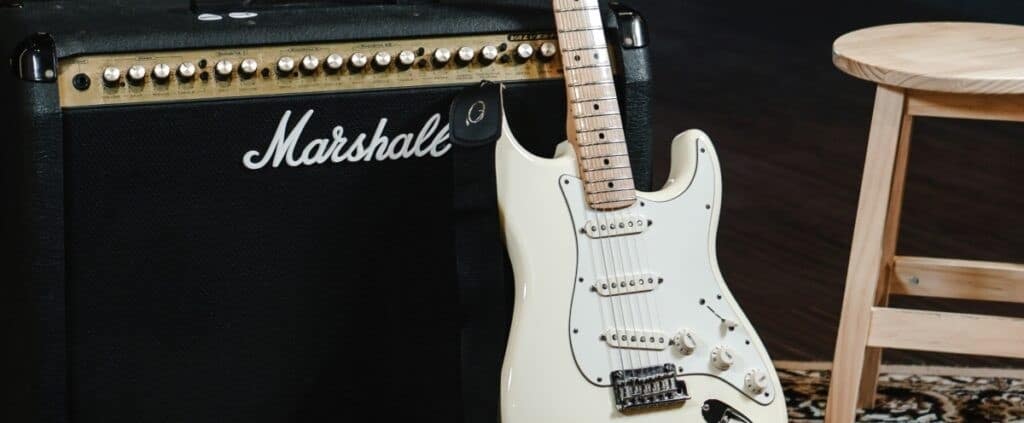Whether you’re a complete beginner or experienced player, choosing which guitar amplifier to buy can be tricky. In this article, I’ll take you through a complete buyer’s guide with all the considerations you need to make so you can narrow down the huge selection of amps and find the perfect one for you.
At a Glance
When deciding which electric guitar amplifier to buy, consider if you want a combo amp or stack amp first, then choose if you want it to be solid state or use tube (valve) technology. Decide what power rating (wattage) and features you need and then try the suitable amps in a store if possible.
Contents
- Types of Amplifier
- How Many Watts Do I Need?
- Which Features Do I Need?
- Testing the Amp in Store
- Popular Amp Brands
- Top Picks

Types of Amplifier
In order to quickly narrow down the number of amps available to you, consider what type of amplifier you’re looking for. There are two things to think about here.
Combo vs Stack
The first thing you should decide, is if you want a combo or a stack amplifier setup. This might sound confusing if you’re a total beginner but it’s actually really simple.
Amps consist of two parts: the “head” which is responsible for processing the signal for your guitar, and the “cabinet”, which receives the signal from the head and converts the energy into the sound. For simplicity, think of the cabinet as another way of describing a speaker.
In a combo amp setup, both these components are in a single all-in-one piece of equipment, whereas with a stack amp, they are two separate pieces of equipment that are, you guessed it, stack on top of each other.

Here is a table to compare the pros and cons of each amp type.
| Pros of Combo Amps | Pros of Stack Amps |
| Inexpensive – you only need one piece of equipment which works out cheaper overall | Versatile – you can pair the head with different cabinets to create different tones |
| Easy to setup – you don’t need to connect the head and cabinet and make sure they’re compatible | More volume – these are typically louder as you can purchase larger cabinets |
| Compact – they don’t take up much space making them perfect for home use | Good for gigs – the head can be taken to gigs and paired with cabinets at the venue |
If you’re a beginner or are only planning on using the amplifier at home, then go with a combo amp. They are much cheaper and easier to use. If you are using the amp for gigging, then consider a stack amp as it’s much more versatile. Stack amps are rarely chosen for beginners because the starting price is much higher than a combo amp.
Unsure which is best for you? Check out my more in-depth comparison of stack and combo amps to help you make your decision.
Tube (Valve) vs Solid State
The second decision you should make to narrow down the choice, is whether you want a valve (aka tube) amp or solid state amp. This is a separate decision to the stack/ combo choice, as it only refers to the technology that the head part of the amp uses. So you can get a valve stack amp or valve combo amp, same goes for solid state amps.
So what does this mean? Well let’s take a look at them separately first.
Tube (Valve) Amplifiers
These were the first type of amplifier to be created. They’re called tube amps in the USA and valve amps in the UK. For ease, I’ll just call them tube amps from here on in.
They work by using tubes which are essentially glass cylinders inside the amp that allow the signal to run through them to create the tone. There are many types of tubes, all which sound slightly different to give the amp it’s unique sound.
Tube amps are considered less versatile than solid state amps because they are designed to each have a unique tone. However, many players prefer the tone of tube amps because they sound a bit more authentic and responsive. Tube amps typically have either 1 or 2 channels (clean or dirty).
The problem with tube amps is that they’re quite expensive, and they’re a bit more difficult to use. You have to make sure the amp has warmed up for around 15-20 minutes before playing it after turning it on. The tubes can also break and need to be replaced, particularly if the amp isn’t well cared for.
Solid State Amplifiers
These use transistors instead of tubes to create the tone. They are criticised by tube amp fans for sounding more artificial, but they are a lot more versatile than tube amps. Typically, solid state amps have multiple “channels” allowing you to change the voice of the amp from clean to crunchy to full-fat metal distortion.
There is also another kind of amp type called the “modelling amp”. This again uses transistors like the standard solid state amps but takes the versatility a step further. Essentially they are designed to emulate the tone of other amplifiers so you can get one amp that’s packed with different tones. They sound very close to tube amps in a lot of cases but some players still will prefer the true tube amp sound.
As well as being more versatile, solid state amps are much cheaper than tube amps and are a lot lighter.
Make sure you check my in-depth guide comparing solid state and tube amplifiers so you can decide which is the best option for you.

Which is Best?
| Pros of Solid State Amps | Pros of Tube Amps |
| Low maintenance (no need to replace tubes) | More authentic sounding |
| More versatile | More iconic |
| Lighter and smaller (for same power rating) |
As you can see, solid state amps are all-round better options unless you simply prefer the tone of a tube amp. For beginners, your best option is a solid state amp and all entry-level models will use this technology. However, for intermediate and advanced players, it really depends on which factors are most important to you.
Try not to get sucked in by the argument that “tube amps always sound better” because it’s often hard to tell the difference if you’re comparing it to a good solid state amp, particularly a modelling amp. Go into a store and listen to the amps you’re interested in and try and do a blind test with a friend to remove any bias.
Next Steps
Okay so from here you should know which amp type you want out of the following choices:
Valve combo amp
Valve stack amp
Solid state combo amp
Solid state stack amp
Here’s why they sit on the average price spectrum.

If you want to learn more about the average prices of different amplifier types, then check out my article on how much guitar amps cost for plenty of examples.
How Many Watts Do I Need?
Once you’ve figured out what type of amplifier you want, you can start to think about wattage.
So, more watts equals more volume right? Well, yes. But there’s a lot more to the story than that. As well as wattage, there are two other factors which affect volume:
- Cabinet size
- Amplifier type
Cabinet size impacts volume quite significantly, and it’s why a 100W amp will sound much louder through a 4×12″ cabinet compared to a 1×12″. The 4×12″ creates more air flow since there are 3 more speakers compared to the 1×12″. So make sure you consider this too.
Amplifier type also has a huge impact on volume, and here I’m referring to tube amps and solid state amps. A 100W tube amp will sound louder than a 100W solid state amp. That’s why it’s important to look at the amp type first before moving onto the power (wattage).
I’ve written a full guide explaining how to work out what size amp you need so make sure you check it out before you make your purchase. But for the sake of this article, here is a quick table to summarise what power ratings are needed for different situations.
| Purpose | Solid State | Valve/ Tube |
| Practice amplifier | 10-20W | 5-10W |
| Gigs with no drummer in venues holding <100 people | 40-50W | 20-30W |
| Small gigs with a drummer | 50-100W | 30-50W |
| Gigs with 100-1000 people | 200W | 100W |
| Gigs with >1000 people | 200W and microphone | 100W and microphone |
Key Point: the relationship between wattage and volume is not linear. For example, a 100W amp is not 10x louder than a 10W amp, even if you keep all other variables the same. So don’t get too caught up when comparing say a 20W with a 25W amp, or a 40W amp with a 50W amp, because in practical terms, the volume difference is quite small.
Also, whilst having more volume might seem like a good idea, it’s not the best practice to go for. Amps often sound best when played at mid-volume, so cranking up an amp to max or having it on minimum volume usually won’t sound great. That’s why it’s important not to choose an amp that’s too powerful or weak for a particular setting.

Which Features Do I Need?
At this point you should have a much smaller selection of amplifiers to consider, and that’s where we get to the nitty gritty.
At this point you can start to consider which features you really need. If your selection is small enough at this point, you can also go and try the different models in the store to see which sounds the best to you. But if you’ve still got over 5 amps left to consider, looking at the features is your best bet to getting a more manageable amount of amps to try.
Controls and Channels
Having more controls on an amplifier allows you to tweak the tone more precisely and achieve a more specific sound, but having too many controls can make it confusing. Solid state modelling amps tend to be the most complex and include a variety of channels to create different tones.
Effects
Some amplifiers have built-in effects, which means you may not need to use pedal effects. Again, solid state modelling amps tend to include the most effects, followed by standard solid state amps and finally tube amps typically don’t include effects except for maybe reverb.
For beginners, having some built-in effects is really useful because it allows you to experiment and figure out what kinds of sounds you like. However, they typically aren’t as high quality and as flexible as pedal effects, which is why professionals tend to use pedals instead of amp effects.
Check out my article comparing pedal and amplifier effects to learn more.
Other Features
Here is a list of other useful features that you might want to consider:
- FX Loop: these allow you to place pedal effects after the pre-amp stage of the amplifier in the signal chain which is very useful for modulation, reverb and delay effects. This feature is usually found on mid-high end amps and you can learn more about it in my guide to effects loops.
- Footswitch: some amps are compatible with footswitches which allow you to switch between different amp channels using your foot, instead of fiddling with the amp mid-song.
- Tuner: a built-in tuner is very useful for beginners and even professionals when gigging.
- Looper: this is great tool to have for practicing as you can loop your own backing track, or for buskers.
- App Connectivity: some more modern solid state modelling amps can connect to apps on desktop or mobile which allows you to access further settings, save settings and even update the amp with new features.
- AUX input: this is useful if you want to plug in your phone or other smart device so the amp plays backing music that you can play along to.
- Headphone output: very useful if you don’t want to annoy your neighbours!
- Outputs for external speakers or for recording: useful if you’re a professional player.

Guitar Center are always the first place I look at when I’m interested in a new amp because have a huge range of amplifiers for sale and always have some excellent deals on. Here’s a link to take you directly to Guitar Center’s amp range so you can see all the offers available at the moment.
Testing the Amp in the Store
Hopefully at this point you’ll have narrowed down your selection to a manageable number. This is when you need to go to your local store and try the amps out. Make sure you take your guitar with you so you can get an idea of the tone you will achieve, or use the same model in the store when testing it out.
Don’t be shy and take as long as you need. Try all the settings on the amp and ask the store assistant if you’re unsure of what any of them do.
If you’re a total beginner, you can still listen to the amp, just kindly ask the store assistant to play a few different things and take you through the settings so you can properly experience the amp. Most store assistants will jump at the chance to show off their skills!
If you’re unable to try the amp in store, then head over to YouTube and try and find some demos or comparisons with other amps you’re interested in.
Popular Amplifier Brands
There are tonnes of amplifier brands on the market, here are some of the most popular and reputable:
- Fender: famous for American clean tones and spring reverb.
- Marshall: best known for iconic British crunch tones.
- Orange: perfect for rock and metal.
- Vox: perfect for classic rock tones.
- Blackstar: produce versatile entry-level of professional amps.
- Boss: best for solid state modelling amps.
If you’ve already got your eye on a few brands, check out these articles:
I also have tonnes more comparison articles and guides in the amplifier category of this website.
Top Picks
To round off this article, I’ve listed some of my top amplifier picks. They all include links to Amazon so you can check out the current prices.
Starter Amplifier
Blackstar ID: Core 10
- Easy to use
- Plenty of effects and controls
- Great value for money
Solid State Modelling Amplifier
Boss Katana 50W
- Packed with features
- Wattage control for different volumes
- Impressive price
Classic American Tone
Fender 68 Custom Deluxe Reverb
- Amazing clean tones
- Iconic reverb effect
Iconic British Crunch Tone
Marshall JCM 800 Studio Classic
- Great for home use
- Classic British crunch
Perfect for Metal
Orange Rockerverb 50
- Punchy and aggressive distorted tone
- Bright and chimey clean tones
If you’re looking for a Marshall amp, check out my complete guide to the range and cost of the different models to learn more.





